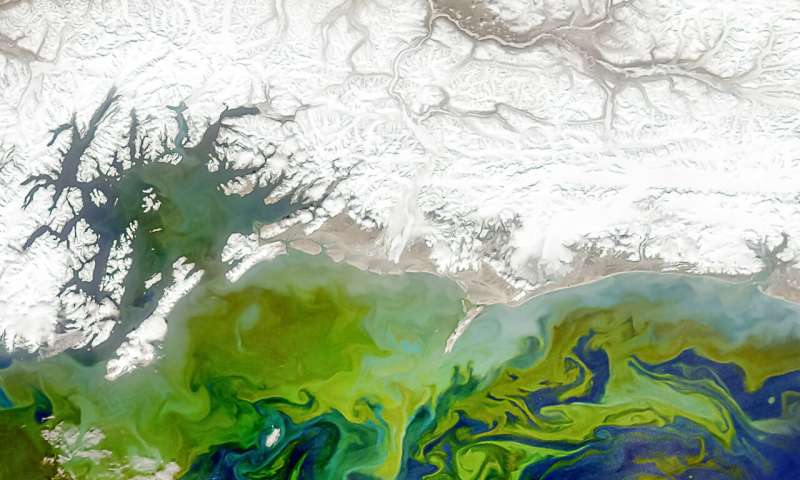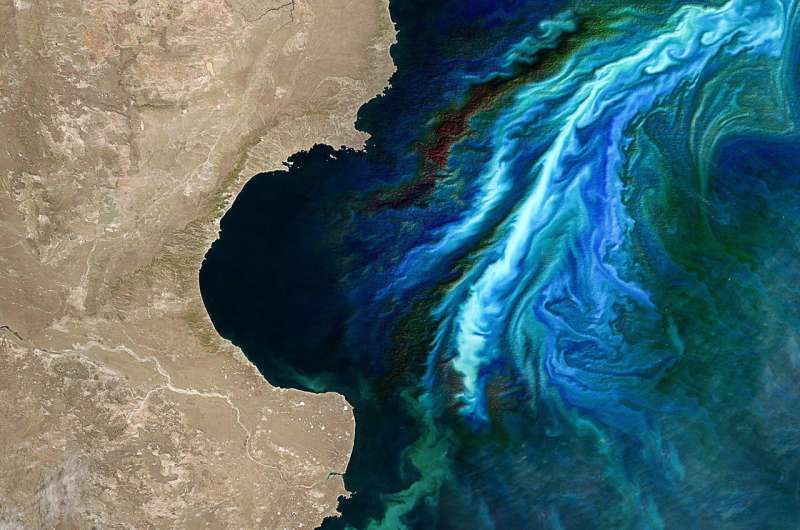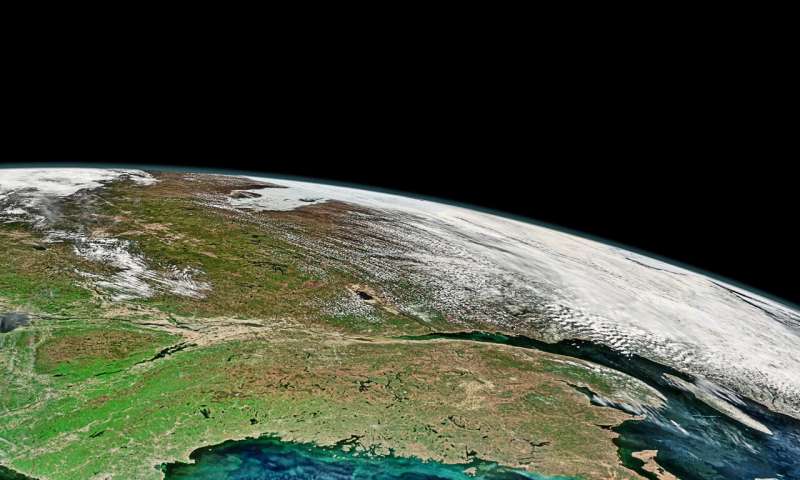Satellite images show coastal algae blooms have grown larger over past two decades
A team of Earth scientists affiliated with multiple institutions in China and the U.S. has found that coastal algae blooms (also known as phytoplankton blooms) have been getting bigger over the past couple of decades. In their study, published in the journal Nature, the group analyzed satellite data supplied to them by NASA to compare the size and frequency of algae blooms along the coasts of the world’s continents.
Algae blooms are accumulations of algae in a shared area atop a water source. Algae are aquatic plants that contain chlorophyll, but have no leaves, roots, stems, vascular tissue or flowers. They vary in size, from single-celled species to large strands of seaweed. They can have different colors and can inhabit either fresh or saltwater systems. Algae blooms grow larger as their food source grows, particularly nitrogen and phosphorus, both of which are supplied indirectly through human sources such as fertilizer runoff.
Prior research has shown that algae blooms can serve as a food source for some sea creatures, but they can also cause problems, such as carrying and dispersing toxic material. Such toxins have been found to accumulate in ocean networks, sometimes leading to oxygen depletion, which can lead to ocean dead zones. In this new effort, the research team found evidence that algae blooms are getting larger, which suggests fertilizer runoff has been increasing.
-
![Satellite images show coastal algae blooms growing larger over past two decades]()
Caption: Intensifying phytoplankton blooms in earth’s coastal oceans. Credit: Lian Feng
-

Caption: Intensifying phytoplankton blooms in earth’s coastal oceans. Credit: Lian Feng
The work involved studying satellite images obtained from NASA’s Aqua satellite over the years 2003 to 2020. By comparing such blooms over time, they found them to be growing at an increasing rate of 59.2%, globally. They also found that as of 2020, the combined size of all ocean-based algae blooms was 31.47 million km2, which, they note, is approximately 8.6% of total ocean surface area.
The researchers also found patterns of increase—the areas where the water temperatures were rising the fastest were the same areas where the algae blooms were growing the fastest. Additionally, they found associations between sea surface temperatures, ocean circulation and the frequency of algae blooms.
More information:
Yanhui Dai et al, Coastal phytoplankton blooms expand and intensify in the 21st century, Nature (2023). DOI: 10.1038/s41586-023-05760-y
© 2023 Science X Network
Citation:
Satellite images show coastal algae blooms have grown larger over past two decades (2023, March 2)
retrieved 2 March 2023
from https://phys.org/news/2023-03-satellite-images-coastal-algae-blooms.html
This document is subject to copyright. Apart from any fair dealing for the purpose of private study or research, no
part may be reproduced without the written permission. The content is provided for information purposes only.

A team of Earth scientists affiliated with multiple institutions in China and the U.S. has found that coastal algae blooms (also known as phytoplankton blooms) have been getting bigger over the past couple of decades. In their study, published in the journal Nature, the group analyzed satellite data supplied to them by NASA to compare the size and frequency of algae blooms along the coasts of the world’s continents.
Algae blooms are accumulations of algae in a shared area atop a water source. Algae are aquatic plants that contain chlorophyll, but have no leaves, roots, stems, vascular tissue or flowers. They vary in size, from single-celled species to large strands of seaweed. They can have different colors and can inhabit either fresh or saltwater systems. Algae blooms grow larger as their food source grows, particularly nitrogen and phosphorus, both of which are supplied indirectly through human sources such as fertilizer runoff.
Prior research has shown that algae blooms can serve as a food source for some sea creatures, but they can also cause problems, such as carrying and dispersing toxic material. Such toxins have been found to accumulate in ocean networks, sometimes leading to oxygen depletion, which can lead to ocean dead zones. In this new effort, the research team found evidence that algae blooms are getting larger, which suggests fertilizer runoff has been increasing.
-
![Satellite images show coastal algae blooms growing larger over past two decades]()
Caption: Intensifying phytoplankton blooms in earth’s coastal oceans. Credit: Lian Feng
-

Caption: Intensifying phytoplankton blooms in earth’s coastal oceans. Credit: Lian Feng
The work involved studying satellite images obtained from NASA’s Aqua satellite over the years 2003 to 2020. By comparing such blooms over time, they found them to be growing at an increasing rate of 59.2%, globally. They also found that as of 2020, the combined size of all ocean-based algae blooms was 31.47 million km2, which, they note, is approximately 8.6% of total ocean surface area.
The researchers also found patterns of increase—the areas where the water temperatures were rising the fastest were the same areas where the algae blooms were growing the fastest. Additionally, they found associations between sea surface temperatures, ocean circulation and the frequency of algae blooms.
More information:
Yanhui Dai et al, Coastal phytoplankton blooms expand and intensify in the 21st century, Nature (2023). DOI: 10.1038/s41586-023-05760-y
© 2023 Science X Network
Citation:
Satellite images show coastal algae blooms have grown larger over past two decades (2023, March 2)
retrieved 2 March 2023
from https://phys.org/news/2023-03-satellite-images-coastal-algae-blooms.html
This document is subject to copyright. Apart from any fair dealing for the purpose of private study or research, no
part may be reproduced without the written permission. The content is provided for information purposes only.

